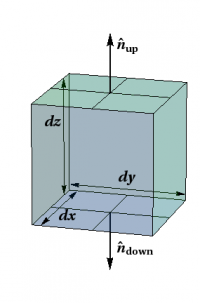You are here: start » book » math » divergence
Divergence
 Figure 1: Computing the vertical contribution of the flux through a small
rectangular box.
Figure 1: Computing the vertical contribution of the flux through a small
rectangular box.
Consider a small closed box, with sides parallel to the coordinate planes, as shown in Figure 1. What is the flux of $\EE$ out of the box?
Consider first the vertical contribution, namely the flux up through the top plus the flux down through the bottom. These two sides each have area element $dA=dx\,dy$, but the outward normal vectors point in opposite directions, that is \begin{eqnarray*} \nn_{\hbox{up}} &=& \kk \\ \nn_{\hbox{down}} &=& -\kk \end{eqnarray*} so we get \begin{eqnarray*} \sum_{\rm top+bottom} \EE \cdot d\AA &=& \EE(z+dz) \cdot \kk\> dx\,dy - \EE(z) \cdot\kk\> dx\,dy \\ &=& \Bigl( E_z(z+dz) - E_z(z) \Bigr) \> dx\,dy \\ &=& \frac{E_z(z+dz) - E_z(z)}{dz} \> dx\,dy\,dz \\ &=& \Partial{E_z}{z} \>\> dx\,dy\,dz \end{eqnarray*} where we have multiplied and divided by $dz$ to obtain the volume element $dV=dx\,dy\,dz$ in the third step, and used the definition of the derivative in the final step. 1)
Repeating this argument using the remaining pairs of faces, it follows that the total flux out of the box is \begin{eqnarray*} {\rm total flux} = \sum_{\rm box} \EE \cdot d\AA = \left( \Partial{E_x}{x} + \Partial{E_y}{y} + \Partial{E_z}{z} \right) \> dV \end{eqnarray*} Since the total flux is proportional to the volume of the box, it approaches zero as the box shrinks down to a point. The interesting quantity is therefore the ratio of the flux to volume; this ratio is called the divergence.
At any point $P$, we therefore define the divergence of a vector field $\EE$, written $\grad\cdot\EE$, to be the flux of $\EE$ per unit volume leaving a small box around $P$. In other words, the divergence is the limit as the box collapses around $P$ of the ratio of the flux of the vector field out of the box to the volume of the box. Thus, the divergence of $\EE$ at $P$ is the flux per unit volume through a small box around $P$, which is given in rectangular coordinates by \begin{eqnarray*} \grad\cdot\EE = \frac{\rm flux}{\rm unit volume} = \Partial{E_x}{x} + \Partial{E_y}{y} + \Partial{E_z}{z} \end{eqnarray*}
You may have seen this formula before, but remember that it is merely the rectangular coordinate expression for the divergence of $\EE$; the divergence is defined geometrically as flux per unit volume. Similar computations can be used to determine expressions for the divergence in other coordinate systems. Because of the geometric nature of divergence, these expressions turn out to give the same value at any point in space.